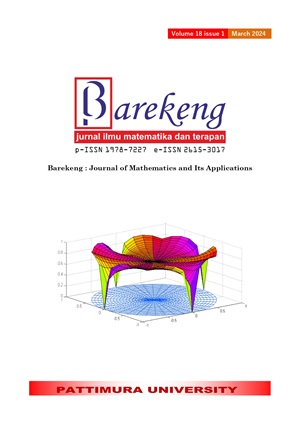COMPARISON OF LOCAL POLYNOMIAL REGRESSION AND ARIMA IN PREDICTING THE NUMBER OF FOREIGN TOURIST VISITS TO INDONESIA
Abstract
Indonesia is a country that has a variety of exotic tourist destinations and can attract tourists to visit. Currently, tourism is one of the sectors that plays a major role in driving the Indonesian economy. Various tourists, both domestic and foreign, are expected to continue to increase in number every year. Therefore, appropriate policies are needed from the government to develop the tourism sector so that it can be even better over time. This research aims to predict the number of foreign tourist visits to Indonesia using the Autoregressive Integrated Moving Average (ARIMA) model and local polynomial regression. The data used in this research is the number of foreign tourist visits per month from January 2017 to December 2022 obtained from the the Kemenparekraf website. This data is fluctuating so that the method a local polynomial approach is appropriate for this study. The data analysis method used are local polynomial regression and ARIMA model. In the ARIMA model there are assumptions that must be met. In this study, the ARIMA model obtained has met the assumption of residual normality but does not meet the assumption of homoscedasticity so that ARIMA modeling cannot be continued and analysis is only carried out with local polynomial regression. The result of this study is a prediction of future tourist visits. The MAPE value of the local polynomial regression approach is 1.43% which is categorized as a prediction with high accuracy because the value is less than 10%. Thus, the local polynomial regression approach is very well used to predict the number of foreign tourist visits to Indonesia.
Downloads
References
CNBC Indonesia, 2019. [Online]. Available: https://www.cnbcindonesia.com/market/20190319084140-17-61460/bi-pariwisata-bisa-jadi-penyumbang-devisa-terbesar-kedua. [Accessed 10 April 2023].
C. C. Lab, W. Swesti, F. Alfian, A. N. Pajriyah, N. Bachtiar, N. Yatimah, S. Razak and J. Bramantio, Outlook Pariwisata & Ekonomi Kreatif Indonesia, Indonesia: Kemenparekraf, 2021.
Satudata Kemenparekraf, 2022. [Online]. Available: https://satudata.kemenparekraf.go.id/. [Accessed 10 April 2023].
S. Isnawati, Statistik Tenaga Kerja Pariwisata dan Ekonomi Kreatif 2018-2021, Jakarta: Kemenparekraf, 2022.
B. G. Prianda and E. Widodo, "Perbandingan Metode Seasonal ARIMA dan Extreme Learning Machine pada Peramalan Jumlah Wisatawan Mancanegara ke Bali," Barekeng Jurnal Ilmu Matematika dan Terapan , vol. 15, no. 4, pp. 639-650, 2021.
J. Hendrian, Suparti and A. Prahutama, "Pemodelan Harga Emas Dunia Menggunakan Metode Nonparametrik Polinomial Lokal Dilengkapi GUI R," Jurnal Gaussian, vol. 10, no. 4, pp. 604-616, 2021.
A. Meimela, "Prediksi Jumlah Kunjungan Wisatawan Mancanegara ke Indonesia," Media Wisata, vol. 19, no. 1, 2021.
V. Fibriyani and N. Chamidah, "Fibriyani, V., & Chamidah, N. (2021). Prediction of Inflation Rate in Indonesia Using Local Polynomial Estimator for Time Series Data," Journal of Physis: Conference Series, vol. 1776, no. 1, pp. 0-10, 2021.
Sugiyono, Metode Penelitian Kuantitatif, Kualitatif dan R&D, Alfabeta, 2016.
Sugiyono, Metode Penelitian Kuantitatif, Kualitatif dan R&D, Alfabeta CV, 2013.
N. P. A. M. Mariati, I. N. Budiantara and V. Ratnasari, "Combination Estimation of Smoothing Spline and Fourier Series in Nonparametric Regression," Journal of Mathematics, vol. 2020, pp. 1-10, 2020.
R. J. Hyndman and G. Athanasopoulos, Forecasting: Principles and Practice (3rd ed), Melbourne, Australia: OTexts, 2021.
L. A. Yates, Z. Aandahl, S. A. Richards and B. W. Brook, "Cross Validation for Model Selection: A Review with Examples from Ecology," Ecological Society of America, vol. 93, no. 1, 2022.
Suparti and A. Prahutama, "Pemodelan Regresi Nonparametrik Menggunakan Pendekatan Polinomial Lokal pada Beban Listrik di Kota Semarang," Media Statistika, vol. 9, no. 2, pp. 85-93, 2016.
N. P. A. M. Mariati, I. N. Budiantara and V. Ratnasari, "Smoothing Spline Estimator in Nonparametric Regression (Application: Poverty in Papua Province)," in 7th International Conference on Research, Implementation, and Education of Mathematics and Sciences (ICRIEMS 2020), Atlantis Press, 2020.
N. P. A. M. Mariati, I. N. Budiantara and V. Ratnasari, "The Application of Mixed Smoothing Spline and Fourier Series Model in Nonparametric Regression," Symmetry, vol. 13, no. 11, 2021.
I. Nabillah and I. Ranggadara, "Mean Absolute Percentage Error untuk Evaluasi Hasil Prediksi Komoditas Laut," Journal of Information System, vol. 5, no. 2, pp. 250-255, 2020.
Rory and R. Diana, "Pemodelan Data COVID-19 Menggunakan Regresi Polinomial Lokal," in Seminar Nasional Official Statistics 2020, 2020.
Irwandi and D. P. Sari, "Analisis Metode Arima pada Peramalan Nilai Ekspor Sumatera Barat," UNPjoMath, vol. 6, no. 4, pp. 9-15, 2021.
Copyright (c) 2024 Nur Chamidah, Bagas Shata Pratama, Alda Fuadiyah Suryono, Nina Auliyah

This work is licensed under a Creative Commons Attribution-ShareAlike 4.0 International License.
Authors who publish with this Journal agree to the following terms:
- Author retain copyright and grant the journal right of first publication with the work simultaneously licensed under a creative commons attribution license that allow others to share the work within an acknowledgement of the work’s authorship and initial publication of this journal.
- Authors are able to enter into separate, additional contractual arrangement for the non-exclusive distribution of the journal’s published version of the work (e.g. acknowledgement of its initial publication in this journal).
- Authors are permitted and encouraged to post their work online (e.g. in institutional repositories or on their websites) prior to and during the submission process, as it can lead to productive exchanges, as well as earlier and greater citation of published works.






1.gif)



